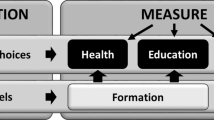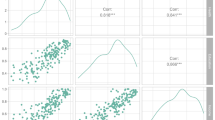Abstract
This paper seeks mainly to contribute to the debate on how the relative degree of development of a country should be measured by proposing an indicator to build on the valuable starting point provided by the Human Development Index (HDI). The indicator proposed is called the “Composite, Dynamic Human Development Index”. It incorporates in a simple way additional points which are significant for the current concept of human development and provides a dynamic factor that distinguishes between countries on the basis of achievements attained. It helps ensure that the static average data on which the HDI is based does not conceal wide-ranging economic, social and political differences within countries, lack of sustainability in current levels of development or effective development strategies drawn up by governments.

Similar content being viewed by others
Notes
His intention can be summed up in a single sentence: ‘‘to shift the focus of development economics from national income accounting to people centered policies’’ (Haq 1995).
If ∆HDI1980–2010j < 0, the value 0 is adopted; the highest average annual HDI growth rate for 1980–2010 is that of Nepal with 2.37 %.
We propose the calculation of the arithmetic mean for the 8 components Cji (by contrast with the criterion adopted in 2010 by the UNDP for calculating the HDI, which is now the geometric mean of the components) for four reasons: (1) because when one of the components of the geometric mean is zero, that mean is not determined and with there being 8 components in Cji it is increasingly likely that this situation will arise; (2) because the existence of those 8 components neutralises to a greater extent the potential appearance of extreme values, to which the arithmetic mean is highly sensitive when there are fewer components; (3) because the statistical significance of the arithmetic mean is more intuitive than that of the geometric mean; and (4) because the geometric mean is always lower than or equal to the arithmetic mean, so it is preferable to have a greater capacity for differentiating between the values obtained for the different countries from the ordinal viewpoint.
References
Ahluwalia, M. S., & Chenery, H. (1974). The economic framework. In H. Chenery, et al. (Eds.), Redistribution with growth. Policies to improve income distribution in developing countries in the context of economic growth (pp. 38–60). Oxford: Oxford University Press.
Anand, S. & Sen, A. (1993). Human Development Index: methodology and measurement. Human Development Report Office Occasional Paper 12, PNUD, New York.
Anand, S., & Sen, A. (2000). The income component of the Human Development Index. Journal of Human Development, 1(1), 83–106.
Bardhan, K., & Klasen, S. (1999). UNDP’s gender-related indices: A critical review. World Development, 27(6), 985–1010.
Bhagwati, J. (1993). India in transition. Freeing the economy, Oxford University Press, New York.
Bilbao-Ubillos, J. (2011). The limits of Human Development Index: The complementary role of economic & social cohesion, development strategies and sustainability. Sustainable Development (forthcoming). Article first published online: 18 May 2011, doi:10.1002/sd.525.
Briassoulis, H. (2001). Sustainable development and its indicators: Through a Planner′s Glass darkly. Journal of Environmental Planning and Management, 41(2), 409–427.
Chakravarty, S. R. (2003). A generalized Human Development Index. Review of Development Economics, 7(1), 99–114.
Chowdhury, S., & Squire, L. (2006). Setting weights for aggregate indices: An application to the commitment to development index and Human Development Index. Journal of Development Studies, 42(5), 761–771.
Cornwall, A. & Gaventa, J. (2001). From users and choosers to makers and shapers: Repositioning participation in social policy. IDS Working Paper 127, Institute of Development Studies, Brighton.
Deneulin, S. (2004). Human development. Participation and gender. Special lectures. San Salvador: Universidad Centroamericana José Simeón Cañas.
Domínguez, R., Guijarro, M., & Trueba, C. (2011). Recuperando la dimensión política del desarrollo humano. Sistema, 220, 11–31.
Doraid, M. (1997). Analytical tools for human development. New York: PNUD.
Dossel, D. P., & Gounder, R. (1994). Theory and measurement of living levels: Some empirical results for the Human Development Index. Journal of International Development, 6, 415–435.
ECLA (1991). El desarrollo sustentable: Transformación productiva, equidad y medio ambiente. Santiago de Chile: United Nations.
Ediger, V. S., & Tatlidil, H. (2006). Energy as an indicator of human development: A statistical approach. The Journal of Energy and Development, 31(2), 213–232.
Fukuda-Parr, S., Lawson-Remer, T., & Randolph, S. (2010). An index of economic and social rights fulfillment: Concept and methodology. Journal of Human Rights, 8(3), 195–221.
Furtado, C. M. (1967). Teoria e política do desenvolvimento econômico. São Paulo: Companhia Editora Nacional.
Gormely, P. J. (1995). The Human Development Index in 1994: Impact of income on country rank. Journal of Economic and Social Measurement, 21, 253–267.
Griffin, K. & Knight, J. (Eds.) (1989). Human development in the 1980s and beyond. Journal of Development Planning 19, 9–40.
Grimm, M., Harttgen, K., Klasen, S., & Misselhorn, M. (2008). A Human Development Index by income groups. World Development, 36(12), 2527–2546.
Hagerty, M. R., Cummings, R. A., Ferriss, A. L., Land, K., Michalos, A. C., Peterson, M., et al (2001). Quality of life indexes for national policy: Review and agenda for research. Social Indicators Research, 55(1), 1–96.
Haq, M. Ul. (1973, March 22). System is to blame for the 22 wealthy families. The London Times.
Haq, M. Ul. (1995). Reflections on human development: How the focus of development economics shifted from national income accounting to people-centred policies, told by one of the chief architects of the new paradigm. Oxford University Press, New York.
Herrero, C., Martínez, R. & Villar, A. (2010). Improving the measurement of Human Development. UNDP Human Development Research Paper, nº 2010/12.
Hicks, D. A. (1997). The inequality-adjusted Human Development Index: A constructive proposal. World Development, 25(8), 1283–1298.
Huggins, M. (2005). Género, políticas públicas y promoción de la calidad de vida. Caracas: Instituto Latinoamericano de Investigaciones Sociales.
Ivanova, I., Arcelus, F. J., & Srinivasan, G. (1999). An assessment of the measurement properties of the Human Development Index. Social Indicators Research, 46, 157–179.
Kaufmann, D., Kraay, A. & Mastruzzi, M. (2008). Governance matters VII: Aggregate and individual governance indicators, 1996–2007. World Bank Policy Research Working Paper, 4654, Washington, D.C.
Lind, A. (1992). Power, gender, and development: Popular women’s organizations and the politics of needs in Ecuador. In A. Escobar & S. Alvarez (eds.), The making of social movements in Latin America: Identity, strategy, and democracy. Westview Press, Boulder, pp. 132–149.
Maddison, M. (1986). Las fases del desarrollo capitalista. México: FCE.
Mazundar, K. (2003). A new approach to Human Development Index. Review of Social Economy, 61(4), 535–549.
Mcgilivary, M. (1991). The Human Development Index: Yet another redundant composite development indicator? World Development, 19, 1461–1468.
Mcgilivary, M., & White, H. (1993). Measuring development? The UNDP’s Human Development Index. Journal of International Development, 5, 183–192.
Milanovic, B. (2005). La era de las desigualdades. Madrid: Editorial Sistema.
Munda G. (2012). Choosing aggregating rules for composite indicators. Social indicators research (in press); Published on line: 9 September 2011. doi:10.1007/s11205-011-9911-9.
Murray, J. L. (1993). Development data constraints and the Human Development Index. In D. G. Westendor & D. Ghai (Eds.), Monitoring social progress in the 1990’s (pp. 40–44). Aldershot: Avebury.
Myint, H. (1958). The ‘classical theory’ of international trade and the underdeveloped countries. The Economic Journal, 68(2), 317–337.
Neumayer, E. (2001). The Human Development Index and sustainability—A constructive proposal. Ecological Economics, 39, 101–114.
Noorbakhsh, F. (1998). A modified Human Development Index. World Development, 26(3), 517–528.
Nussbaum, M. C. (2000). Women and human development: The capabilities approach. New York: Cambridge University Press.
OECD (2008). Handbook on constructing composite indicators: Methodology and user guide. Paris: OECD Publishing.
Ranis, G. & Stewart, F. (2005). Dynamic links between the economy and human development. Department for Economic and Social Affairs Working Paper, No.8, United Nations, New York.
Ravallion, M. (2010). Troubling tradeoffs in the Human Development Index. Policy Research Working Paper WPS 5484, The World Bank, Washington.
Sagar, A. D., & Najam, A. (1998). The Human Development Index: A critical review. Ecological Economics, 25, 249–264.
Saltelli, A. (2007). Composite indicators between analysis and advocacy. Social Indicators Research, 81, 65–77.
Sen, A. K. (1984). Resources, values and development. Oxford: Blackwell.
Sen, A. K. (1993). Markets and freedoms: Achievements and limitations of the market mechanism in promoting individual freedoms. Oxford Economic Papers, 45, 519–541.
Sen, A. K. (1999). Development as freedom. Oxford: Oxford University Press.
Sharpe, A. (2004). Literature review of frameworks for macro-indicators. Centre for the Study of Living Standards Research Reports, no 2004-03, CSLS, Ottawa, Canada.
Srinavasan, T. N. (1994). Human development: A new paradigm or reinvention of the wheel? American Economic Review, Papers and Proceedings, 84, 238–243.
Stanton, E. A. (2007). The Human Development Index: A history. Political Economy Research Institute Working Papers Series, number 127, University of Massachusetts, Amherst.
Streeten, P. (1981). First things first: Meeting basic human needs in developing countries. Oxford: Oxford University Press.
Streeten, P. (1994). Human development: Means and ends. American Economic Review, 84(2), 232–237.
Trabold-Nübler, N. (1991). The Human Development Index: A new development indicator? Inter Economics, 236–243.
undp. (1990). Human development report 1990. Concept and measurement of human development, Oxford University Press, New York.
UNDP (2010). Human development report 2010–20th Anniversary edition. Pathways to human development. New York: Oxford University Press.
undp (2011). International human development indicators. Data tools and visualizations. UNDP, New York.
Varshney, A. (1998). Democracy, development and the countryside. Cambridge: Cambridge University Press.
Zambrano, E. (2012). Functionings, capabilities and the 2010 Human Development Index. New York: Human Development Report Office.
Zhou, P., & Ang, B. W. (2009). Comparing MCDA aggregation methods in constructing composite indicators using the Shannon-Spearman measure. Social Indicators Research, 94, 83–96.
Zhou, P., Ang, B. W., & Zhou, D. Q. (2010). Weighting and aggregation in composite indicator construction: A multiplicative optimization approach. Social Indicators Research, 96, 169–181.
Author information
Authors and Affiliations
Corresponding author
Rights and permissions
About this article
Cite this article
Bilbao-Ubillos, J. Another Approach to Measuring Human Development: The Composite Dynamic Human Development Index. Soc Indic Res 111, 473–484 (2013). https://doi.org/10.1007/s11205-012-0015-y
Accepted:
Published:
Issue Date:
DOI: https://doi.org/10.1007/s11205-012-0015-y




